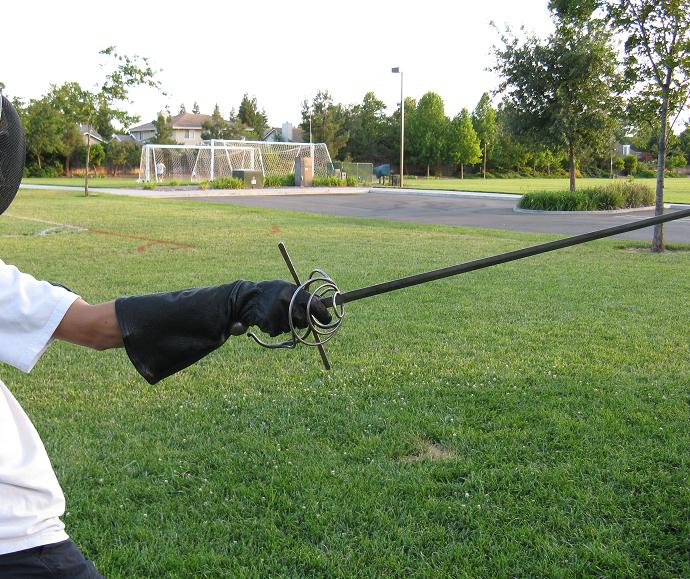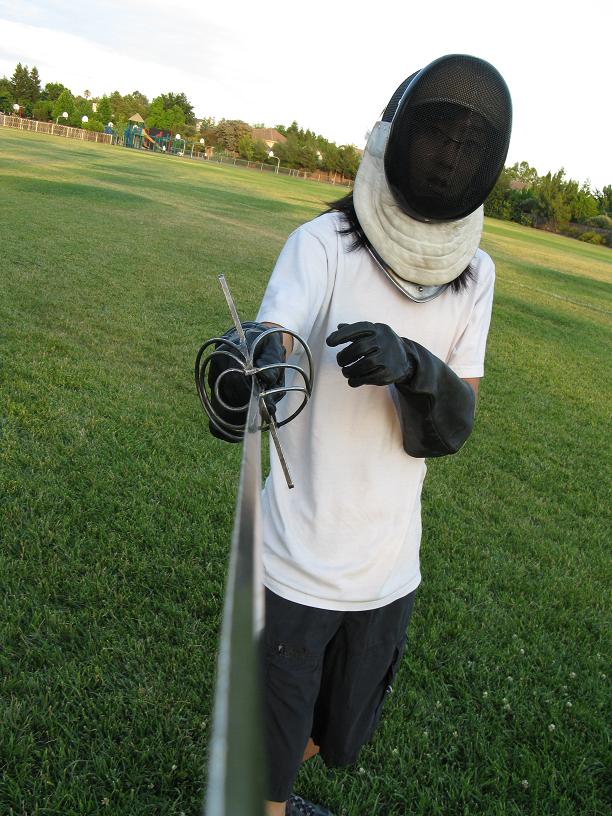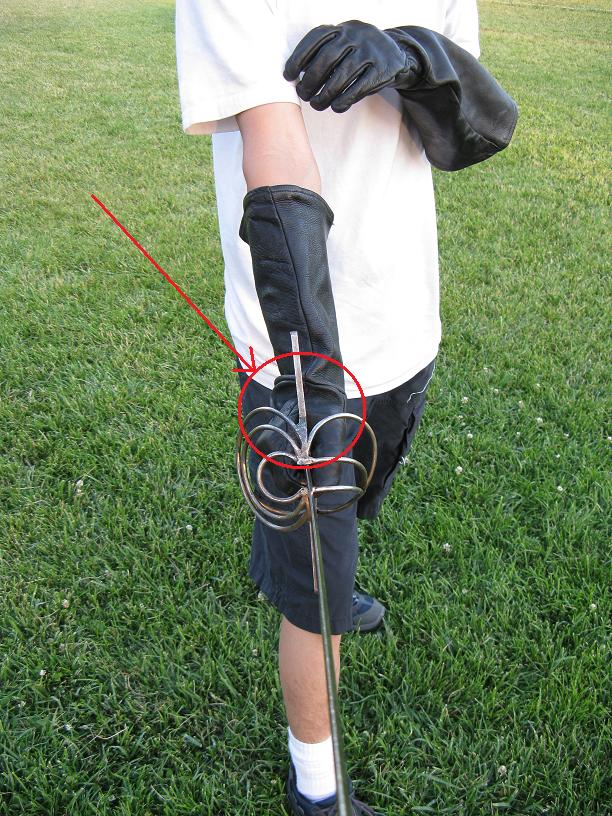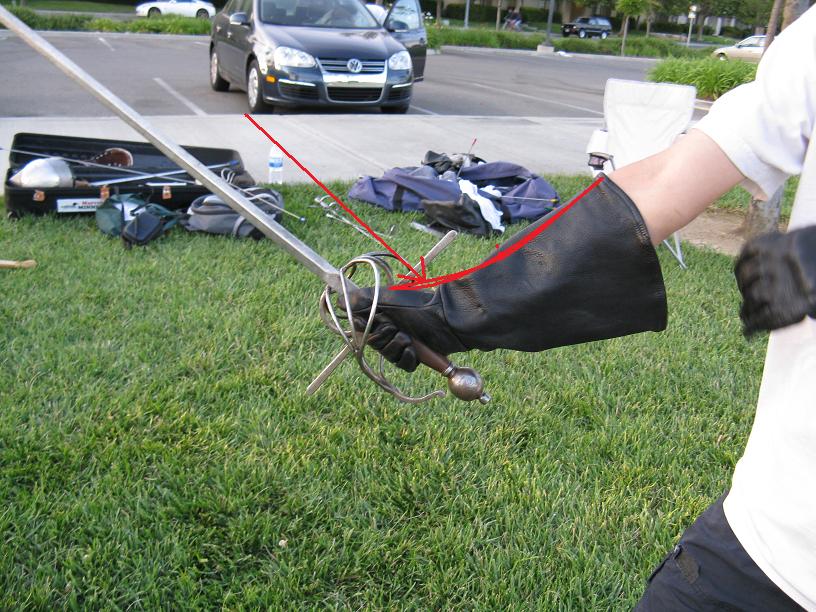Uncle Puck’s Doorway
(6/3/2009)
This article is a fencing tip for amateur rapier fencers. In Italian rapier and classical fencing the arm is held straight from elbow to tip. Fabris favors an extended and straight arm, but he discusses the sword held at an angle as well.
——————————————————-
Those who hold the sword at an angle (with either the hand in third just above the knee or in second higher and outside the knee) do fortify their sword, but pay the price in giving the opponent much bigger openings and allowing him to come closer.
Fabris’ 1606 text as translated by Tom Leoni
And also this concerning the sword held at an angle:
It is much better to hold the arm withdrawn and the sword straight so as to form a direct line between the elbow and the point.
Fabris’ 1606 text as translated by Tom Leoni
Compare that to this 1997 classical Italian text:
In the completed guard the weight of the body should be distributed equally between the legs, with the torso profiled, and inclining slightly forward, head up and turned to the right, eyes on the adversary, shoulders down, right arm well extended and relaxed, elbow in line with the flank, hand in central position on the line of offense, midway between invitations in third and fourth, and forearm and weapon forming an unbroken line.
Gaugler’s Science of Fencing
——————————————————-
From these two quotes we can see that the Italians are wary of extending a bent wrist forward. A sword that is extended in a straight line from elbow to tip protects the hand behind the guard.
From the front, the opponent’s perspective is more obvious. (Notice below that the swept hilt protects not only the hand but the entire forearm as well.)
Most amateur fencers don’t realize this target is exposed and they open a line to an easy attack that I call Uncle Puck’s Doorway. On a swept hilt rapier there is a V-shaped notch where the rings meet the sweeps and the superior half of the cross.
When this angle exists in the wrist, it creates a nice landing pad for an attack to the top of the arm. The bend in the wrist acts as the perfect backstop for the attack.
An adversary who holds a sword extended and forward with an angle in the wrist is the gift that keeps on giving. If you are an SCA fencer and you are aware of this line of attack, you can be very effective in tournaments and group combat because newer SCA fencers often make this mistake.






There are some local instructors here in the Bay Area who shall remain unnamed and who teach their students the angled arm. Untraining them is very difficult, but hitting that arm is not.
By Jeremy on June 4, 2009 2:52 pm
I don’t have a problem with an angled arm in the right situation. (Swetnam’s guards are an example of a bent arm, but the arm is withdrawn just as Fabris describes.)
An arm that is extended forward with a bent wrist as shown in the pictures is the first thing I look for when my adversary comes on guard because it is the safest attack a short guy like myself can make, especially against an adversary I don’t know. Capoferro advices us to do this against a ‘bestial man’ and as far as I concerned everyone is a beast until proven otherwise.
😉
~P.
By puck on June 5, 2009 12:02 am
Saviolo uses a bent wrist, but it should be noted that in his wards, in most cases, the hand is withdrawn so that the arm cannot be attacked. I would really say that it depends on what you are teaching. The later more extended guards place the arm in such a position, whereas the earlier ones have it much more withdrawn and therefore better protected.
Cheers,
Henry.
By Henry on June 9, 2009 3:37 am
Don’t ignore the possibility that the bent wrist is an invitation from a fencer who is good at picking up the opponents blade and locking it in his quillions.
By Orlando on August 17, 2009 5:40 pm
Henry,
I agree that Saviolo seems to be alright with his arm withdrawn.
Orlando,
I wouldn’t say I am ignoring the possibility but I personally don’t think locking the adversary’s weapon with the cross is a good trade off for the risk.
To use Capoferro’s description of time, an attack to the arm is a half tempo (mezzo tempo) action and it will be very quick. That jab into the wrist is going to be very fast and while locking with the cross might work occasionally in friendly play, I wouldn’t want to bet my bones and flesh on it. If my adversary wants to present this invitation to the wrist I’ll be happy to capitalize on it because my risk is pretty low. If he gets luck enough to lock my blade in his cross, I’ll break distance to free the weapon.
Then there is a possibility that the adversary may try to run me down. SCA fencers tend to big on bum-rushing people because there is no game penalty for it. In an actual encounter, someone that gets my point offline and charges me is going to get a percussive strike with as much force as I can deliver as I break distance. That could be a wheeling cut driven off their beat or it could be a strike with the pommel in close quarters. If that still fails, we wrestle and I go for the eyes, nose, and mouth. (Fiore is an Italian too.)
In any case, my point was to demonstrate that the Italian masters from a wide range of history (1606 – present day) tell us that extending the arm forward with a bent wrist is bad fencing and we can take advantage of it if we recognize it.
~P.
By puck on August 18, 2009 5:34 pm